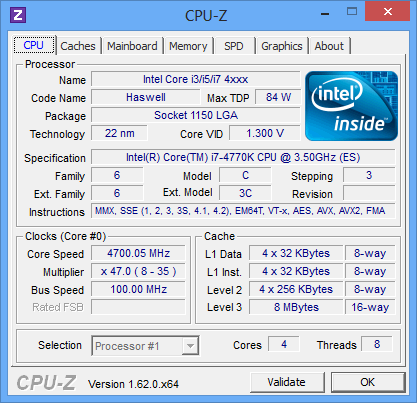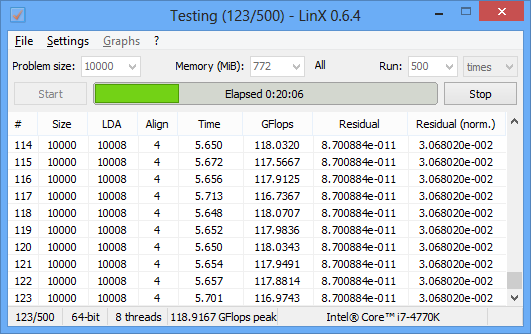Nine Big Air Coolers For Intel's Haswell CPUs, Reviewed
Intel's Haswell-based CPUs have a unique cooling problem that leaves many overclockers in a quandary. Today, we're rounding up nine different sink and fan combinations to see if any can contend with the fourth-gen Core processor's copious heat.
The Equalizer: Our Core i7-4770K Review Sample
Why you can trust Tom's Hardware
One small detail that went largely overlooked in that already-mentioned launch article was voltage. Our source, whose retail processors were topping out in the 4.3 to 4.4 GHz range was only using 1.2 V to maintain low heat levels. After all, he's selling Haswell-based systems that need to remain stable through multiple years of warranty coverage. Meanwhile, I was pushing my press sample harder with 1.3 V. Was he being overly cautious? Was I too aggressive? Could my cooling situation really be that much better? Or might differences in stress testing account for everything?
One of our contacts recommended LinX to test the Hasewell architecture's advanced AVX 2.0 pipeline, suggesting it'd yield temperatures significantly higher than Prime95. Although we didn't see the delta he did, LinX does get somewhat hotter. It's even more taxing than the Intel stress test I used in our first Z87 Express motherboard round-up.
Switching to LinX broke my previous overclocking thermal limit at 1.3 V, forcing a drop to 1.25 V. The reduced voltage in turn dropped my “ragged edge” maximum to 4.6 GHz. Rather than trying to perfect that 4.6 GHz and worry about what might happen to it in the future as the sample started degrading, I informed today's invitees that we would test at 1.25 V and 4.50 GHz.
I also informed invitees that any cooler that allowed our CPU to bump the processor’s 100° Celsius thermal limit would need to be disqualified from this article’s conclusion.
Like the source Chris Angelini queried for his launch article, I could have also used 1.2 V to play it safe and limit my own overclocks to 4.4 GHz. But why would I do that? If I use my old MUX-120 review sample as a starting point, shouldn’t all of today’s top coolers be better?
Current page: The Equalizer: Our Core i7-4770K Review Sample
Prev Page Picking The Right Cooler For Haswell Next Page Gamer Storm AssassinGet Tom's Hardware's best news and in-depth reviews, straight to your inbox.
-
jk_ventolero The CM H212 Evo has been a crowd favorite for quite some time now. :) I wonder how that might have performed. :DReply -
blackmagnum Water cooling is the best way forward: less noise, energy efficient and low maintenance.Reply -
CaptainTom I hate to say it but all this article demonstrated to me is that Haswell is in no way better than Ivy Bridge. Even Ivy Bridge used 25% less energy with a 10% boost when compared to Sandy Bridge, and I can still get IB to 4.8 GHz on air.Reply
Haswell= 10% more power for 10% more energy and 10% less headroom. Oh and it costs more...
Man I hope AMD can whip them back into shape with Steam Roller... -
s3anister I can't even fathom why one would spend this much time to write an article like this and still leave the NH-D14 out.Reply -
spazoid It's funny how some of you guys still think Intel made Haswell with desktops in mind. This is a CPU architecture made for mobile. It's quite sufficient for desktops in every regard. Yes, it might not outperform IB by much, and it might run a bit hotter, but in a laptop, there is nothing that compares to Haswell.Reply -
Crashman Reply
Noctua picked the NH-U14S instead of the D14. Please feel free to ask them why.11158600 said:No NH D14?
Since Noctua chose not to feature the NH-D14 this time, you might want to look at its closest competitor. The article links a comparison of Phanteks TCP14E and NH-D14. Since Phanteks chose to keep its big cooler in the running but Noctua chose otherwise, this was the closest "frame of reference" available.
I can't even fathom why you would repeat the first post without regard to any response. And speaking of a response, please read above.11159094 said:I can't even fathom why one would spend this much time to write an article like this and still leave the NH-D14 out.
-
Shneiky Really disappointed that there was no be quiet! and Cooler Master representatives. I would enjoy seeing how a Dark Rock Pro 2 or a V8 GTS/V6 GT.Reply -
flong777 The comments are correct concerning the omission of the NH-D14 from this testing. It really doesn't matter a damn what "Noctua picked," that is not the issue. The FACT is the D14 is legendary for its cooling and to leave it out of any major test is just plain stupid. Don't forget that it won your last competition for best cooler.Reply
To say compare it's performance with the Plantek's performance is lame. Use some common sense when you do these reviews.


